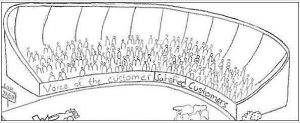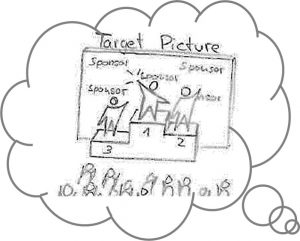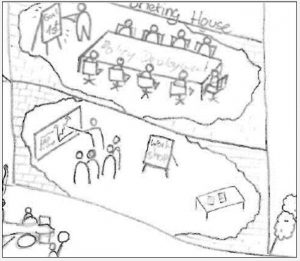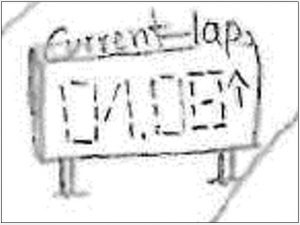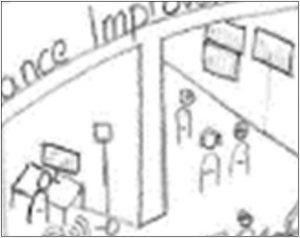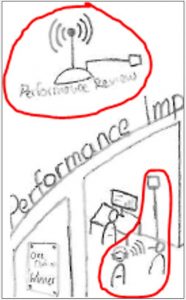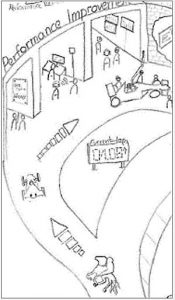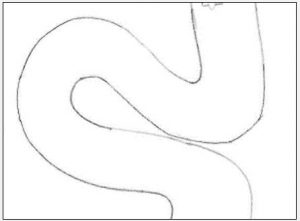Barriers that Lead to 5S Failure in Manufacturing
Article Summary
5S is a lean tool that is utilized to reduce waste and maximize efficiency. 5S implementation can be beneficial to an organization in terms of improved quality, reduced costs, standardizing work processes and financial gains. Manufacturing has been linked as the origination of 5S. 5S developed in Japan combines workplace organization through the use of efficiency, effectiveness and safety [1]. It has evolved to other sectors such as healthcare, service and office settings.
The intent of discovering 5S manufacturing failure connects to other industries that share the same concerns of reducing costs, standardizing processes and improved quality. 5S is beneficial when it is successfully implemented and sustainable. When 5S fails the barriers that cause the failure must be determined to understand the failure of 5S in a manufacturing workplace. The barriers can occur at any of the 5S stages and thus the outcome of a failed 5S project needs direction on what stage it fails and what actions are needed following a failed 5S project. Identification of barriers that lead to 5S project failure will determine the effectiveness of the 5S stages.
Definition of 5S as a success or failure
5S failure requires a definition of what a failed project is. To understand what a failed project is, a successful 5S project should be defined. There are many cases of successful results of 5S.
The US Bureau of Economic Analysis conducted a study in 2011 on the value-added dollar of manufacturing represented 12.2 per cent of industries in the US. In 2015 the Center for Automotive Research released a report that revealed 5S tools and lean continuous improvement methods contributed to $500 billion annual compensation of 1.5 million automotive jobs. [2]. Financial drivers are the underlining focus of many 5S projects.
The development of 6S
5S success has led to the incorporation of adding Safety as the 6S. A case study on Medium and Micro-Small enterprises created a paperless system and a sustainable waste recycling program making the outcomes of the project a success.
Process improvements and addressing safety were the main concerns for utilizing 5S. This study eliminated waste processes and also introduced safety factors such as better hygienic conditions, eco-friendly waste disposal practice and improved housekeeping methods. 5S integrated into 6S with the sixth S being safety. [3].
Lean popularity
Lean had gained popularity that spread through manufacturing. Many manufacturing organizations began to jump on the lean bandwagon utilizing tools such as 5S, Poka-Yoke, Kanban systems, just-in-time and Kaizen events as they followed suit of what other organizations were attaining. A case study by The Industry Week/MPI Census of Manufacturers resulted in 70% of plants in the U.S is utilizing a form of lean manufacturing as an improvement method. The study did not focus on if lean was the correct tool for the organizations.
A further look at the same IW/MPI survey displays that only 2% of companies who responded to the survey have fully achieved their objectives and less than a quarter of all companies, 24% reported achieving significant results. That leaves 74% of the responding companies admitting that they are not making good progress with Lean [4]. A successful 5S project is one that is repeatable over time without any diminished effects.
Motives & problems
There are numerous motives for implementation of 5S as there are explanations why 5S fails to deliver the results for a manufacturing organization. The main problems associated with sustaining 5S provides knowledge to quality professionals for understanding 5S. The importance of the investigation is to understand how 5S works so well for one organization and not for another. As a baseline tool in lean concepts, 5S is what many consider the introduction on the start of a lean journey [5].
Download
COVID-19: Building Resilience & Adapting to Change
Crisis and CI
As Covid-19 pandemic pushes the global economy into a recession of historic proportions, we are observing a remarkable phenomenon. Companies that have a robust culture of ‘continuous improvement’ are doing significantly better than their competition.
I am talking about companies where a lean and agile management system is just the way they work, rather than a standalone tool for reducing waste or solving immediate failures. These companies are much quicker in adapting to change and there is a simple reason for that: they have a more robust defense mechanism that effectively acts like a vaccine against disruption.
The traditional company approach
 Consider a traditional company’s improvement approach, where essentially, problem solving is a top-down exercise whereby the frontline and middle managers highlight problems as they encounter them and the top management endeavors to come up with solutions to address those problems.
Consider a traditional company’s improvement approach, where essentially, problem solving is a top-down exercise whereby the frontline and middle managers highlight problems as they encounter them and the top management endeavors to come up with solutions to address those problems.
This is likely to be your own company and as you probably already have experienced, there is often a significant disconnection between the actual issue and the solution put in place, since the problem solvers (senior managers and dedicated change project teams, let’s call them black belts for ease) did not personally experience the actual issue or are overburdened by the volume of change that is needed
To make the matter worse, very soon the middle management learns that there is intense competition as to which problems are allocated precious change resources. So, they have no choice but to aggrandize their issues to ensure resources are received. What ensues is political game playing in prioritisation of change projects
The CI company approach
In a CI company, however, the relationship is reverse. It is not the top management’s job to commonly offer solutions and implement changes, rather it  is to clearly communicate the general direction and intentions of the firm and enable middle management and frontline staff to resolve any issues they encounter.
is to clearly communicate the general direction and intentions of the firm and enable middle management and frontline staff to resolve any issues they encounter.
So the solutions don’t come from the top, the performance challenges do! The countermeasures are identified and applied by the frontline teams and their line management. This of course, needs a deep conviction that the ‘doers’ know the capability of existing standard work and the problems best and they are better placed to create the right countermeasures.
It takes investing in people’s problem solving capabilities and allowing them regular time and resources to resolve the issues. But, arguably more importantly, it needs giving frontline and middle management ‘the license to experiment’ which in turn becomes an important cultural currency for the organization to absorb change and to constantly be able to adapt to changing environment
CI Leadership
It also needs an appetite in leadership to encourage and support many small improvements that add up to big changes but individually are rapid and low risk, rather than a prevailing stereotype where we must have the one big save or compelling project that is high risk.
Importantly, it means changing leadership habits at all levels of the organisation. Habits lead to behaviours and the culture in turn is the collection of those behaviours. Leaders with those changed habits are seen to show a constancy of direction for their teams, they encourage and coach an incremental mindset where small change is valued and failure, normally of low risk, is seen to be a chance to learn and improve.
Meeting the challenge: a case study
It is in the face of adversity and in tough times such as these that CI companies truly shine. I was talking to a director at a leading Financial Services organisation recently. She was telling me how their management system of continuous improvement was helping to save the day. As a result of Covid-19 this company was one of the first in the world to shift to remote working and sometimes entire buildings had to be evacuated and whole work teams connected from home.
Not only did they have robust plans in place to deal with the situation, but also their CI management system, which included robust visual management boards, cascaded KPI’s and simple but regular problem solving huddles helped everyone remain focused on what mattered most to the customer.
In fact, to work remotely they nearly did not need to change anything, as far as their management system was concerned. Years of investing in and trusting people, meant that the “doers” knew exactly what needed to be done and that they were adapting to the customers rapidly changing needs at a great pace.
The frontline analysts and customer facing agents did not need to wait for the top to first understand the change and then to design the right recipe for the customer. It was the frontline’s job to adapt and address the change. The top had to adapt too. It was important to protect and enable the middle and the frontline by supporting team management and problem solving. To get close to their ‘Gemba’ and ensure the customers and the frontline are cared for. The idea of going to the Gemba or workplace was not new to this company, rather part and parcel of their culture of CI.
In conclusion
Today it is encumbered on middle and senior management, more than it has ever been, to rid themselves and their companies of the culture of command and control, and to adopt a culture of CI. The keyword in command and control is control. Senior executives often think they are not doing command and control because they are not commanding in an autocratic fashion, which is often true. But the part that we need to let go of, is the control part.
This may be the biggest lesson Coronavirus has to teach us yet. To let go and to be prepared to live with our vulnerability and to embrace change as the only constant. This is going to be the new normal, and traditional companies that do not adapt to this new way will fade away quickly.
Finally, it is normal for us and for our colleagues to be feeling isolated, anxious and even confused. Resilience will only come if we face our inner anxieties. Remember this is the very time to resort to robust coaching and to use evidence-based science in coping with uncertainty and anxiety. Coaching is an essential element in creating a culture of CI. We cannot issue an edict and expect company’s culture to change overnight. Creating the right habits and behaviours often takes practice and whilst there are no shortcuts, good coaching will engender good habits quicker than we think. .
More information
I will be addressing the issue of coaching through Covid-19, using the newly emerging scientific field of positive psychology, in a series of open webinars starting in few days and focused on supporting you build more resilience for yourself as well as for your company – see Coaching through Disruption (Part I) and Coaching through Disruption (Part II). If this is prompting some reflections on your own business condition and you were wondering how you get started, I would be pleased to hear about your own story and the unique issues you might be facing.
A Short Guide to Quickly Setting Up an Online Course
The Challenge
 In the current crisis, traditional classroom-based learning has virtually stopped overnight, so the challenge for those who need to keep continuous improvement training going is to find an alternative online delivery method so they can maintain activity.
In the current crisis, traditional classroom-based learning has virtually stopped overnight, so the challenge for those who need to keep continuous improvement training going is to find an alternative online delivery method so they can maintain activity.
If you do not have access to a learning management system, you will need to quickly identify a platform to use that can be implemented rapidly.
Fortunately, there is now a large and established industry providing a range of online options, including sophisticated eLearning Platforms and Learning Management Systems (LMS), offering varying levels of sophistication and, of course, cost of set up.
Responding Quickly
 However, developing a ‘professional’ bespoke online course takes time and resources, while the pressing need is to get something up and running fast, at least as a short term to a medium solution that will keep the training momentum going and deliver benefits to learners and organisations.
However, developing a ‘professional’ bespoke online course takes time and resources, while the pressing need is to get something up and running fast, at least as a short term to a medium solution that will keep the training momentum going and deliver benefits to learners and organisations.
The obvious solution is to use one of the existing web/video conferencing or communications platforms and make some quick adaptations to material originally designed for face to face delivery. It may not have the professional polish of the specialist bespoke offerings, but with a little work, it can be very acceptable and effective.
Article contents
This article provides information and advice that will enable you to set up an online course relatively quickly, largely using the material developed for a face to face environment. It covers:
- The typical features of web conferencing platforms
- Key points to consider when setting up and implementing
- What platforms are available?
- Learning management systems
- Resources
Typical Features of web/conferencing platforms
 Video communications and remote conferencing platforms – including Microsoft Teams, Skype for Business, Google Hangouts Meet, WebEx, Zoom etc – can deliver online workshops/tutorials, virtual classrooms or webinars and can provide an interactive and media-rich learning experience.
Video communications and remote conferencing platforms – including Microsoft Teams, Skype for Business, Google Hangouts Meet, WebEx, Zoom etc – can deliver online workshops/tutorials, virtual classrooms or webinars and can provide an interactive and media-rich learning experience.
Typical features include:
- Captions; instantaneous text appearing on the screen as a person speaks – can be useful if a participant is a noisy environment
- File sharing; files can be shared during the live meeting
- Joining on different devices – PC’s laptops, tablets, mobiles
- Join the session via the provider’s desktop app or through a URL on your browser. The app typically automatically installs when you first join a web meeting
- Live program showing
- Polling/voting; a good way to immediately identify topics and concerns that are top-of-mind for the audience.
- Q&As; participants can ask questions, post comments and get replies from the moderator. Other participants can read the posts and respond to them in real time. This also allows for dynamic meeting content because a facilitator can be alerted whether more elaboration or clarification is needed.
- Recording the session, allowing viewing for those not able to attend or for review, revision
- Scheduling of meetings
- Screen sharing, not just for the presenter/facilitator, but any participant.
- Slideshow presentations
- Virtual breakout rooms
- Whiteboarding – where the presenter or participants draw over charts, images, or mapping out various concepts from scratch.
Key Points to Consider
“The most important principle for designing lively eLearning is to see eLearning design not as information design but as designing an experience.” Cathy Moore
Online Course Planning

- According to Workcast, the most popular days for webinars are Tuesday, Wednesday and Thursday
- The general consensus is that a webinar should be no longer than 60 minutes
- According Media.com:
- Your session should be between 30 and 45 minutes long
- People will only commit to one online session week
- Morning is best for hosting
- You must include a Q&A at the end of your session
- Tuesdays are best for hosting webinars
- Consider sending an expectations questionnaire to participants before the session. This helps you to know the audience, ensure content is relevant and better understand requirements.
- Have a cloud-based folder for the course, to which participants have access (eg Google Drive, Office 365 Onedrive, Dropbox, etc). You can store key documents, handouts, resources and also to allow document collaboration.
- Set up a course-specific group in an instant messaging app, such as WhatsApp, Google Chat or Slack, and use it for simple communications, discussions and feedback.
- Group size: while many platforms can be used with hundreds of participants, for a typical training session with CI practitioners, 7 to 10 is arguably an optimum size, though up to 20 is not uncommon, though it may be becoming unwieldy. Less than 4 participants will limit the benefits of group interaction.
- Set up the meeting effectively. The invite should be sent about a week in advance, with clear aims and expectations, plus any preparation required by participants. You need to send the email invite with the link to the session, as being the meeting ‘owner’ gives you control over certain features, like screen sharing, muting and barring.
- Your plan and overall approach will to a certain extent depend if course participants are from one organisation or several. For the former, you are best to try and utilise the IT architecture and policies of the organisation (and try to get an organisation email address), while for the latter, your design will need more flexibility.
- Gather feedback after the session – either informally (eg “How did we do?” via instant messenger)
- Beware of the corporate firewall when working with one organisation, which may restrict employee access to external sites and services.
- Have a clock visible when delivering, as being prompt is important.
Adapting Material
“Think about what your learners need to do with that information after the course is finished and design around that.” Matthew Guyan
 It will be necessary to adapt your existing material, such as presentation slides, to make it online friendly if you want to avoid developing sophisticated bespoke online training materials.
It will be necessary to adapt your existing material, such as presentation slides, to make it online friendly if you want to avoid developing sophisticated bespoke online training materials.
- Splitting up material into ‘bite-size chunks’. Given that an online session should be no longer than 60 minutes (the most common time used), what was a half-day workshop could be split into three or four sessions, though the timing should be appropriate to what exactly you want to achieve in the session.
- Shorter sessions can be interspersed with homework/group work – eg getting participants to undertake a practical activity which they video
- Being shorter, the session should address probably one major topic or these, or have one main learning outcome.
- Keep slides simple. ‘Less is more’ is important the online and don’t overfill your slides with wordy text.
- Use more visuals
- Include polls and have breaks for questions. Participants can be encouraged to use the chat facility to share ideas and ask questions.
- Leave time at the end for questions and discussion. This can be a great way to engage participants, with their own personal experiences around the topic.
- Consider adding at various points short videos related to the topic. Youtube is obviously a great resource for this.
Adapting Delivery
According to a Microsoft study, the average person’s attention span is eight seconds, so bear this in mind!

- Encourage audience engagement by making use of the interactive features in the platform. For example:
- Continuously engage every three minutes with a poll, a request for input, or an opportunity to contribute in chat.
- Use all of the interaction tools in your web conference platform to keep your learners actively participating. Just make sure that continuous engagement is essential to the purpose of the webinar.
- Don’t talk at them. Instead, look for opportunities to stimulate their interest in your topic with well-placed polls and opportunities to chat
“Where my reason, imagination and interest were not engaged, I would not, or I could not learn”. Winston Churchill
- If you are using slides, avoid those that you only want to show for a few seconds
- Show a slide while you’re taking questions
- Highlight what you want people to look at on the slides. Many platforms have laser pointers when in presentation mode
- Have a Plan B. If you lose your internet connection or your phone gets cut off what are you going to do? Always have a printed or local version of your slides with you, so you can continue to present if you experience any problems with your internet connection
- Let people know when you’re going to be silent
- Use micro-pauses as opposed to long pauses
Assessment
 If you need to assess participants at the end of your online course, there’s a wide range of online options available, many of which are free or have limited free versions, which may be adequate in the short term. including SurveyMonkey and Google Forms.
If you need to assess participants at the end of your online course, there’s a wide range of online options available, many of which are free or have limited free versions, which may be adequate in the short term. including SurveyMonkey and Google Forms.
Some set up is required for an online test and the LCS has resources that can help (and even run tests if necessary).
See the LCS web page on Creating tests
Managing Participants

- Insist mobile phones are turned off and for those at home ensure distractions like pets or children cannot join in
- Suggest that participants use headphones and that they mute their microphones unless they wish to speak – especially if there is background noise.
- Encourage participants to switch on their video. Some estimates suggest that around 70% of communication is non-verbal, which is important in a training context.
- Participants need capable equipment, with which they should be familiar – eg switching on sound/video, muting, volume controls, etc. Ideally, they should be familiar with the platform being used and have had a practice run making a connection if they are first time users.
- Webinargeek.com suggests a desktop computer should be no more than 5 years old and a laptop 3 or 4 years old.
- Internet speed is important and probably a key determinant of the success of the session. This could vary considerably, especially if participants are at home. To help minimise problems in this area and prevent issues, suggest to participants that they:
- Ideally, have at least 5mbps in download and upload.
- Stop any applications on their computers that require too much bandwidth.
- Connect with their ethernet port rather than wifi for the added stability.
- Have the latest version of their browser and make sure it’s a good browser.
- Switch off video, if the bandwidth is low
- Use a physical phone dial-in number to at least have an audio connection if the web connection is lost or not available. Many platforms offer a dial-in phone number to connect to an online session instead of a link.
- If at home, ask other household members to stop using the internet during the session – eg streaming films, game playing, etc
What Platforms are Available?
 There are many platforms that enable text, voice, or video chats, either one-on-one or in a group and many of us will be using these on a regular basis. They don’t require complex installation and are relatively quick to set up, with no major investment, though there will usually be an annual subscription charge.
There are many platforms that enable text, voice, or video chats, either one-on-one or in a group and many of us will be using these on a regular basis. They don’t require complex installation and are relatively quick to set up, with no major investment, though there will usually be an annual subscription charge.
Many of these provide ‘unified communications’ across an entire enterprise, while others just focus on web conferencing and communications.
Which one you choose may depend on what IT ‘ecosystem’ you are already aligned to (eg Microsoft, Google, etc), or that which your customers use. It may be useful to have more than one to call on
Below is a list of some of the main players.
| Name | Description | Notes |
|---|---|---|
| Microsoft Teams.
(Includes Skype for Business) |
|
Only available to Office 365 Business users, though there is a free account with some limitations |
| Skype for Business (formerly Lync) |
|
Users will eventually upgrade from Skype for Business to Teams. |
| Google Hangouts |
|
Free |
| Google Hangouts Meet |
Google Hangouts Chat is the associated business messaging app in G Suite, with team messaging space, virtual rooms for each team project, threaded conversations, so your team can chat and track the progress of the discussion. It has deep integration with G Suite, so you can share content from Drive and Docs, or you can view things like photos and videos directly from the conversation. Review |
Hangouts Meet is part of the G Suite package |
| Cisco WebEx |
|
Free plan available – host up to 50 participants, 1 GB of cloud storage, 40-minute cap on. |
| Zoom |
|
Zoom Free: unlimited number of meetings, capped at 40 minutes |
| GoToMeeting
GoToWebinar GoToTraining |
|
GoToMeeting starts at £12.00/month. GoToMeeting does not have a free version but does offer a free trial. |
| Bluejeans |
|
Trial available
Review 1 Review 2 |
| AnyMeeting |
|
Free trial available
Review 1 Review 2 |
| Cisco Jabber |
|
What is Cisco Jabber?
Review 1 |
Learning Management Systems
For longer term solutions, where you require a more comprehensive and immersive offering, checkout the wide range of online learning platforms, referred to as learning management systems (LMS).
An LMS is an online learning platform providing an integrated set of interactive online services that provides the teachers, learners, parents and others involved in education with information, tools and resources to support and enhance educational delivery and management – http://www.timelesslearntech.com/
- Academy Of Mine
- Adobe Captivate Prime
- CourseCraft
- Docebo
- Educadium
- in2itive
- LearnWorlds
- Ruzuku
- SAP Litmos
- Skillshare
- Teachable
- Thinkific
- Udemy
- WizIQ
Resources

![]() Best Web Conferencing Software from Trustradius.com
Best Web Conferencing Software from Trustradius.com
![]() The Best Video Conferencing Software for 2020 from PC Magazine
The Best Video Conferencing Software for 2020 from PC Magazine
![]() 10 Top eLearning Resources That Help You Learn Anything Today from elearningindustry.com
10 Top eLearning Resources That Help You Learn Anything Today from elearningindustry.com
![]() Rapid e-Learning development process and resources from talentlms.com
Rapid e-Learning development process and resources from talentlms.com
![]() The eLearning Guild’s Handbook of e-Learning Strategy
The eLearning Guild’s Handbook of e-Learning Strategy
![]() The Ultimate eLearning Resources Guide (2020 Update) from learnupon.com
The Ultimate eLearning Resources Guide (2020 Update) from learnupon.com
![]() 10 awesome elearning examples to inspire you in 2020 from elucidat.com
10 awesome elearning examples to inspire you in 2020 from elucidat.com
Five Success Factors for Planning, Building & Running Operational Excellence Programmes
Introduction
This article is a summary of a presentation made for the final assessment component of the LCS Level 3 Programme and puts into context five quintessential success factors for Operational Excellence programmes. These factors affect, to different degree, the three main phases of an OPEX programme, the Plan, Build, and Run phases. Two of the success factors, Empathy and Credibility, address the relationships to stakeholders in the business.
Two others, Impact and Dynamics, are very much focused on Performance against clear metrics, and the fifth, Integration, has both relationship and technical aspects.
Even though all five success factors are required, above all, OPEX programs have to be planned, built, and run in an emphatic manner by emphatic people.
Empathy is essential
Empathy can be defined as the capacity to place oneself in another’s position , in the context of this paper, regarding tools, trades, and technology as much as emotionally.
Empathy is essential, because application of empathy will contribute to overcoming two common challenges for every OPEX program: the Copy Paste Barrier and Systemic Inertia.
The Copy Paste Barrier
Across a number of different OPEX programs, the author observed what can be called the Copy Paste Barrier.

This effect denotes the difficulty to transfer OPEX concepts, ideas, tools and more from one business or functional domain to another. A quite obvious example is to attempt to transfer the notion of one piece flow from a production to an engineering environment. The engineering staff would reject the concept, if it is not decoded and recoded into the domain of engineering, with regards to terms, tools, trades, and technologies.
The barrier blocks a direct superficial transfer without re-coding, i.e. adopting the position of the target audience. A possible translation of one piece flow into the engineering domain is to say that each change to form, fit, or function of a part results into a new revision.
Systemic Inertia
Systemic Inertia results from the fundamental human need to satisfy the sense of belonging to a human system, such as a team, or any other organisational entity, such as a guild of a particular trade. Such human systems are established and upheld by common rules and behaviours. Conformity to these secures the belonging to the system, and hence establishes an inertia with respect to changes of any kind. In a professional context, this is, for example, resistance against changes in the way of working.
Empathy applies in all three phases of an OPEX program
The common place situation for any OPEX program today is that it is launched as an injection into existing, established, and successful company culture. As often as not, in particular the early stages are supported by external staff or staff specifically hired for the program that either way is not fully embedded into the systemic environment.
During the Plan phase, empathy is needed to establish a strong bond with the key stake holders in this phase: the Executive Committee and the most senior leadership. It is necessary to understand the particular expectations on the OPEX program, to translate the chosen overall approach into the language of the corporate business context, and to adapt to the overall communication style.
During Build phase, when the program plan is initially instantiated, it is vital to secure buy in from the early adopters of the OPEX program. Just like for any other customer experience, rejection by the early adopters will radiate faster and further than any positive experience. While this typically will not result directly in termination of an OPEX program, it will set the program significantly back, and recovery requires even more efforts, slowing the program down, i.e. delaying results.
Empathy will as well enable to understand potential flaws or shortcomings in the plan, i.e. aspects that do not work fully as expected, either technically or in terms of communication.
Understanding the actual performance, and moreover the root causes for shortcomings of the OPEX program carries over into the Run phase and has to be continued there.
Opex is about Impact
Often, OPEX programs are, at least initially, positioned as cultural change programs. However, inevitably, the question about impact, and in particular financial impact will arise, apparently within five years after launch. Impact is not necessarily cost reduction, it may as well be, for example, growth in market share, or increased profitability. Known leading indicators for economical success, such as Customer Satisfaction (e.g. Net Promoter Score) or Employ Satisfaction Indices may be included, but do not suffice in isolation.
Only if an OPEX program is directly and strongly linked to the particular impact ambitions of the corporation, it will continue to exist at times, when the competitive situation of the company is under pressure or during a general economical decline.
Establishment and Utilisation of essential OPEX program KPI
These particular impact ambitions have to be established on Executive Board level during Plan phase, and translated into the domain of every environment, where OPEX is launched. In particular over time, the impact objectives of the corporation may change, hence it is an essential task during the Run phase to regularly challenge OPEX objectives and contributions, and adjust to changes in the overall environment.
The outcome of this activity is a set of up to date, robust, and relevant Key Performance Indicators that have a vital role in the continuous PDCA of the OPEX program (see further below). Demonstration of performance against these KPI will be vital for the continuous support for the OPEX program by corporate management.
Position the OE program as an Integrator
Lean has since long jumped the borders of manufacturing and automotive industry. Nowadays we know of, for example, Lean for Public Services or Lean Software engineering. At the same time other concepts such as Agile, New Way of Working, Advanced Product Quality Planning, and many more emerge, and quickly spread beyond their domain origin. The common denominator of all is that they aim to improve performance, the discriminator lies in the means to achieve that. These discriminating means may be technical, e.g. specific tools or methods, or social, e.g. forming new organisational structures such as guilds, tribes etc.
Consequently, OPEX programs will find themselves in a position, where they will have to shape and explain their relationship to other corporate initiatives, which are eventually younger in corporate context, and potentially more attractive because of that. OPEX programs have to position themselves as open and integrative with regards to emerging concepts from the very start, for two reasons:
- Rivalry or even turf wars will alienate the line organisation and ultimately result in an either or decision, which at least limits the reach of both initiatives.
- Secondly, given that the common denominator is improvement, cooperation and integration should be a fundamental principle: it is not forbidden to apply Agile principles in Operational Excellence and vice versa.
Understanding synergies and embracing ideas in a branded framework
Empathy (see above) will enable to understand, how different ideas will support each other for the benefit of the corporation, and where aspects of one or the other may be more fitting to different parts of the business.
OPEX programs can make provisions to be an Integrator by designing their frameworks in an open, extensible manner, i.e. abstaining from an imperative and dogmatic stance. Frameworks should be branded to the corporation and covey two messages: „from us for us“ and „open, flexible, and extensible“. By these measures, integration is built into the framework and positions the OPEX program itself accordingly.
Build credibility based on Results
While every OPEX program should be clearly linked to top level business objectives and deliver positive impact on them (see above), these metrics are relevant predominantly at senior management level, to justify existence and continuation of the OPEX program. During deployment (Build and Run phases) it is necessary to make the program relevant to the specific target audience, answering the question: „what is in for me?“.
It can be regularly observed that practitioners, who already participated in the program can give more convincing testimony and hence create more buy-in to an OPEX program than external examples and theory. The reason for the by far higher effectiveness by credibility lies in the minimisation of the Copy-Paste Barrier and the proximity in the systemic environment.
The Inside-Out approach
OPEX programs can be designed in a way that such multipliers can be leveraged continually, using an Inside-Out approach. Typically, two options are discussed for deployment of an OPEX program: top-down and bottom-up. Both have advantages, and disadvantages, one of which is common to both: the challenge to transition to the next managerial tier: middle management.
The middle management tier in a corporation is, as a generalisation, a proverbial barrier or decelerator. The root cause for middle management to be reluctant to pick up on programs is that this group typically has to implement concurrent change initiatives coming from various functions into operational business, and at the same time keep the operational performance by and large un-affected. Middle management therefore usually makes trade off decisions as what to pursue with which priority.
The Inside-Out approach avoids this barrier by engaging a small, coherent vertical slice of the organisation all at once: from very senior level to front line, and explicitly including the middle management tier. The benefits of this approach are that due to a coherent target audience the technical aspects: tools, trades, and technology, as well as the systemic disposition are homogeneous, so that empathy can be applied more focused and effectively. Furthermore any challenges can be addressed at the right level, using escalation and delegation.
A practical example of the Inside-Out approach is to start within one engineering discipline with in the engineering directorate, then to gradually cover the disciplines, and crossing over to other domains such as procurement or production at the direct interfaces in processes.
Contribution of the Inside-Out approach to Credibility by Results
The Inside-Out approach creates consistent results in a rather short time frame. Though they have limited impact on the overall performance of the program and the key metrics initially, the Inside-Out approach should deliver significant results in the scope of the targeted slice of the organisation. First hand experience enables operational staff on all levels to spread the word about benefits and results through their own network.
The credibility of people within their community in combination with the tangible and relevant results will lower the entry threshold for the next vertical slice, and may even generate a pull. Result based Credibility aids the sustainment of momentum of any OPEX program.
Manage the dynamics
By design and intent, every OPEX program creates its own dynamics: As the maturity of the organisation increases in being operationally excellent, the needs change, for example:
- Capability building may have to be updated to provide more advanced tools and methods to solve more challenging and complex problems;
- Performance management may have to be enhanced, e.g. implementing a balanced scorecard system, as the understanding of the overall performance and dependencies matures;
- Rollout patterns may have to change, when end to end processes evolve as the more effective structure to allocate responsibilities than a strictly functional breakdown.
Next to these internal dynamics, the environment will have its own dynamics: the macro-economic conditions will change, mergers or acquisitions may re-arrange business priorities and so forth.
Consequently, when entering the Run phase, the OPEX program will have to be evaluated continuously against the business value it delivers, and whether the currently targeted business value is still appropriate. In other words, any OPEX program should apply the PDCA cycle onto itself, understand deviations from plans and metrics, and adjust the program accordingly.
This should go without saying, however OPEX programs sometimes forget to do as they preach.
Conclusion
This paper laid out five success factors for OPEX programs:
- Empathy is required in all stages of an OPEX program in order to be able to design, deploy, and sustain a program that truly fits the needs of the corporation in all its branches and is attractive.
- The definition and pursuit of Impact in terms of business value is essential for all OPEX programs. The fundamental notion is „We want to remain successful, not different“. The OPEX program must define SMART metrics to demonstrate its contribution to business value, and the resulting set must include and prioritise financial metrics.
- OPEX programs have to position themselves as Integrators. New ideas emerge constantly and provide an increasing wealth of ways to improve performance, each with unique features as well as commonalities with more seasoned approaches. OPEX programs have to be open for new ideas and pro-actively embed emerging ideas for the benefit of the corporation. This can best be achieved by a branded, declarative framework („from us for us, and flexible“)
- Credibility based on Results is a driver for successful deployment of OPEX programs. Using an Inside-Out approach by engaging a small but coherent vertical slice of the organisation, practical results can be generated in a short time frame. The people involved in their achievement will relay these via their network into the wider organisation. The high credibility of practitioners in their peer groups reduces the entry threshold for the OPEX program or may even create pull.
- High dynamics are natural for an OPEX program. PDCA has to be applied continually to validate the performance of the program against its impact targets and potential need for adaptation due to changing demand resulting from the program itself, as well as from changes in the wider environment.
Even though all five success factors are required, above all, OPEX programs have to be planned, built, and run in an emphatic manner by emphatic people.
The Race of Excellence: Becoming a High-Performance Organisation
1. What is Operational Excellence?
“As the lean movement evolved from learning about quality in the 1980’s to learning about the Toyota Production System in the 1990’s to Lean Six Sigma in the 2000’s, … it lost people and it lost purpose along the way.”[1]
Toyota did not seek to “deploy” tool sets like Lean and Six Sigma or “implement” a Continuous Improvement Culture. Instead, senior leaders would ask the question “Why are you doing this?”, teaching people how to think. And, as illustrated by Jeffrey K. Liker, achieving Operational Excellence would be expressed as the ultimate purpose of the Toyota Production System. [2]
Operational Excellence therefore got picked up as a subject on its own explicitly in the 2010’s. Neither a specific management philosophy nor a particular methodology, it is seen as an integration of all of those enabling to reach Excellence including, but not limited to, Lean Thinking, Six Sigma, Scientific Management, Organisational Design and Leadership Development.
Roger Price summed it up as “building a sustainable competitive advantage through operations management”.[3] Kevin Duggan took these ideas one step further in his book “Design for Operational Excellence: A Breakthrough Strategy for Business Growth”,[4] in which he posits that for true success, we need to connect our improvements so that we achieve a destination of Operational Excellence that will drive business growth.
He debunks the myth of continuous improvement as a never-ending journey towards a goal or vision and replaces it with the idea of Operational Excellence been understood as an exact destination, one that can be taught to people. He therefore defines Operational Excellence as the creation of an operation where each and every employee can see the flow of value to the customer, and fix that flow before it breaks down.[5]
Furthermore, Duggan describes a set of 8 principles that, if consistently applied in the bespoke sequence, will lead to an organisation achieving that target state in the fastest way possible, proven by the three case studies of Parker Hannifin Corp., IDEX Corp. and Hypertherm. Those principles are:[6]
- Design lean value streams
- Make lean value streams flow
- Make flow visual
- Create standard work for flow
- Make abnormal flow visual
- Create standard work for abnormal flow
- Have employees in the flow improve the flow
- Perform ‘offense activities’ (activities that generate business growth)
Given that these principles clearly had evolved within manufacturing environments, Duggan went on to illustrate how these principles could be applied within a service environment in his “Operational Excellence in Your Office”[7] and “Beyond the Lean Office”.[8] In those, he provided practical approaches to understanding and managing service value streams while addressing the real world complexity of high-mix service environments, like five questions for flow in the office that are empowering and drive office employees to create not just flow, but a self-healing, autonomous flow that does not require management intervention.
More recently, Joseph F. Paris Jr. supported the view of Operational Excellence as the ultimate purpose, the destination a leadership team would ultimately strive for aiming to achieve a competitive advantage, when he proposed the following definition of Operational Excellence:
“A state of readiness attained as the efforts throughout the enterprise reach a state of alignment for pursuing its strategies – where the corporate culture is committed to the continuous and deliberate improvement of company performance AND the circumstances of those who work there – and is a precursor to becoming a high-performance organisation.”[9]
Notwithstanding the fact that business improvement methodologies like TPS, Lean Six Sigma, and Process Improvement, which placed their emphasis on processes to gain a competitive advantage, have yielded tremendous success, he posits that “the twenty-first century company will need to go beyond processes and place its emphasis on optimised systems to remain competitive, even viable.”[10] Paris stresses the need to lead change, to ready the company to see major challenges early and maximise its preparedness to engage, and, when the time for action comes, quickly shift from strategy development to strategy execution.
2. The Race Towards Excellence: A Personal Perspective
I find Kevin Duggan’s view of Operational Excellence as an exact destination very compelling, a state that can be achieved by applying specific principles, and that to arrive at a destination, we must not only create just flow, but a self-healing, autonomous flow of value that does not require management intervention. I am equally convinced of Joseph F. Paris jr.’s perspective of Operational Excellence as the ultimate purpose, the destination.
The “state of readiness” to act requires an alignment of efforts throughout the enterprise to pursue its strategies and a corporate culture committed to the continuous and deliberate improvement of company performance, including the circumstances of those who work there. When we achieve that destination, the organisation will be seen as a high-performance organisation, one that most of its members will be very proud of belonging .
In my view, we must therefore develop organisations with the following characteristics:
i. Being Strategy Focused
A strategy-focused organisation is guided by a clear and overriding purpose or raison-d’être, a corresponding vision and mission; an organisation that pursues a strategy derived from its purpose and traces progress of action plans that at the same time are based on an honest reflection of its current condition vs. the desired future state.
In such an organisation, policy will be deployed not only to the lowest level of the organisation, but first and foremost, translated into outcomes for each customer journey and performance for every end-to-end process. Customer Journey owners and End-to-End process owners will own that performance, in other words: be held accountable for it.
At the same time, they will be given the appropriate decision and influencing power to steer the company’s operations in a way that achievement of those objectives remains everyone’s number one.
The Balanced Scorecard will serve as means to reflect the strategy and be cascaded down in the form of performance dashboards with regular dialogues conducted to review the actual results displayed, leading to the identification of countermeasures when and wherever required. Rather than an “Office of Strategy Management” (OSM) as posited by Norton and Kaplan,[11] this consistent performance management cascade will be used as the tool to drive rigorous execution and identify current or potential future deviations as early as possible.
ii. Being Customer-centric & Process-oriented
A customer-centric (outcome-driven) and process-oriented organisation: I share Janne Ohtonen’s view that the most dramatic changes to an organisation’s efficiency and performance may come through an alignment of customer experience with business architecture and innovation.[12]
Today, high-performing organisations like Amazon, Airbnb, Booking.com or have mastered to start thinking outside-in, i.e. to view any existing or new product or service offering strictly from their customer’s perspective first and design the customer touch-points and experiences accordingly instead of falling into the still rampant habit of taking an inside-out perspective, failing to provide memorable customer experiences because the team limits itself by the process capability of today’s business infrastructure.
Knowing and understanding the customer from the first touch with the business throughout their whole life-cycle, and ensuring this understanding translates to true value that grows over time, these companies have connected the business – from front to back – around the customer. To achieve this, customer journeys and value chains have become the principle element around which people are organised, led, incentivised, and managed on a long-term as well as short-term basis rather than functional silos still prevalent.
Functions may still continue with specific expertise and skill set who can be employed to achieve a particular outcome as part of the value-creation process, but may lose relative importance.
iii. Where Leaders don’t create followers, but new leaders
An organisation where leaders don’t create followers, but new leaders, and decisions are made as close as possible to those who have the necessary information (leadership is distributed): A keynote speaker on a top management conference at a former employer stated that “the pace of change in the world will never again be that slow as today – the speed of transformation is only going to increase”. And it affects organisations in a big way as lifespans of top companies are shrinking, according to an Innosight study of the S&P 500 Index:[13]
- US corporations in the S&P500 in 1958 remained in the index for an average of 61 years. By 1980, the average tenure of an S&P500 firm was 25 years, and by 2011 that average shortened to 18 years based on seven year rolling averages. In other words, the churn rate of companies in the S&P500 has been accelerating over time.
- At current churn rate, 75% of the S&P 500 will be replaced by 2027
If that holds true, an organisation that sticks with the traditional “leader-follower” paradigm won’t be able to keep pace with one that adopts the “leader-leader” paradigm and the transformational leadership style demonstrated by L. David Marquet.[14] The future won’t be created by one single person “at the top”, but be built by people who have discovered that leadership is the enabling art of releasing human talent and potential.
A human being’s genius, passion, loyalty and tenacious creativity can’t just be bought with a paycheck – it needs to be volunteered. For this to happen, we need leaders who are able to create environments where people feel safe and like to belong, so everyone will feel encouraged to bring in their ideas to make their leader’s inspiring vision come true.
iv. Deliberately continuously improving & learning and more agile
The distinguishing feature of Taiichi Ohno’s approach when he created the Toyota Production System in the 1970’s[15] was to engage the whole workforce in seeking improvements rather than relying solely on experts, resulting in an engaged workforce with superior problem-solving skills, operating within an organisational culture and infrastructure that genuinely saw mistakes as opportunities to improve, encouraged knowledge sharing and rewarded adoption of good practices.
Now, about 50 years after this ingenious concept was invented, any high-performing organisation should be able to replicate. Not only has the knowledge how to get there been widely shared, but western economies have meanwhile gained practice from production into service sectors and new employees demand to be led in a different way than their predecessors.
At the same time, we have learned how to replace traditional waterfall project management methodologies with agile-like project management, acquired new techniques like design thinking and rapid prototyping, and to see mistakes as learning opportunities, openly sharing with colleagues. All of the above adds up to a high-performance organisation as one that…
Delivers world-class operational performance, is the benchmark for its competitors, admired by its customers, praised by its investors, recommended as great place to work by its associates. Indeed, such companies often develop exemplary ethical and environmental behaviour appreciated by wider society.
3. Visualising ‘The Race of Excellence’
Having run an “Operational Excellence for Senior Leaders” programme across three different organisations during 2018 and 2019, I wanted to concisely convey all of these ideas, showing how they function together. My initial thoughts were to develop a ‘mountain climbing’ model, but felt this may have left people with the question “so what, once we have arrived at the mountain top, what then?” – a one-off event.
My colleague Julius Heruth and I finally arrived at the analogy of a racetrack – like Simon Sinek says, “it’s about an infinite game” – one lap representing one time cycle, maybe a month or a year, and then the whole thing starts again [16].
The concept is thus visualised as single picture – ‘The Race of Excellence ‘.
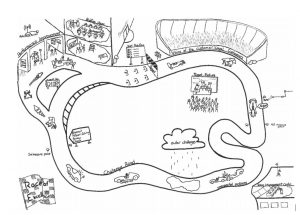
Figure 1: The Race of Excellence (developed by Jörg Baier, drawn by Julius Heruth)
The following table describes each of the above picture’s elements in detail, providing an idea how those are interlinked and at the same time listed in the order in which I recommend those elements to be introduced into an already existing organisation (if not yet established there).
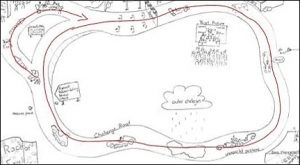 |
(14) The Race: What do you do when you are playing in a game that has no finish line? In the Infinite Game, the goal is not to win – the goal is to get better. To indicate that most organisations are to adopt an infinite mindset, the “Race of Excellence” is taking place on a racetrack where each passing of the finish line means a new lap is being started.
Yes, the specific race is over at some point, giving us time to maintain and improve our equipment, replace broken parts, rewire our brains, retrain and up-skill our team, review and adjust our strategy and respective plans, and improve the way we operate. |
 |
(15) The Finish Line: This pause basically means a shift of activities from one field to another one, not that we can stop being busy. And within a week or two, there is another race to come … As Simon Sinek posits,[16] changing our mindset away from having competitors – other players to be beaten – and rather to adjust that mindset to see those other players as worthy rivals, there to reveal to us our weaknesses so that we may become better versions of ourselves, is the right mindset for the infinite game. The state of Operational Excellence is dynamic and not static – we therefore must stay nimble, flexible, open-minded, agile and ready to sense any changes in the environment, carefully assess whether things are changing, remaining alert in case they are. Once we decide to act, we act decisively and execute rapidly. |
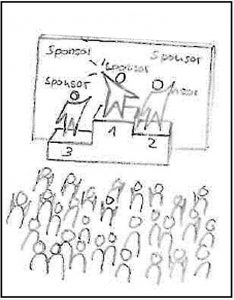 |
(16) The Podium: Luckily, there is time to celebrate success after each race. This is also the time to demonstrate respect for people, recognise and reward meaningful contributions and outstanding performance.
You want to identify good practices and turn them into new standards. It is therefore as well the time to encourage your most capable team members to share their insights and experiences to develop their colleagues. |
Figure 2: The Race of Excellence explained
In Conclusion…
My colleagues and I at E.ON SE have been supporting senior leaders in developing their respective organisations towards operationally excellent ones, employing this model. We have been able to use the logic and sequence of the model to help to build respective capabilities with ‘The Race of Excellence’ approach, yielding desired outcomes and giving valuable feedback, much appreciated by the participants. Each organisation and leadership team is different however, so the approach used should be tailored to their needs.
Jörg M. Baier, February 2020
Literature
- Anthony, S.D., Viguerie, S.P., Schwartz, E.I., Van Landeghem, J. [2018]: 2018 Corporate Longevity Forecast: Creative Destruction is Accelerating, https://www.innosight.com/insight/creative-destruction, retrieved 26 October 2019
- Duggan, K.J. [2012]: Design for Operational Excellence: A Breakthrough Strategy For Business Growth, ISBN 978-0071768245
- Duggan, K.J. [2016]: Beyond the Lean Office: A Novel on Progressing from Lean Tools to Operational Excellence, Productivity Press, ISBN 978-1498712484
- Duggan, K.J., Healey, T. [2016]: Operational Excellence in Your Office: A Guide to Achieving Autonomous Value Stream Flow with Lean Techniques, Productivity Press, ISBN 978-1498714082
- Kaplan, R.S., Norton, D.P. [2008]: The Execution Premium: Linking Strategy to Operations for Competitive Advantage, Boston, Massachusetts, ISBN 978-1422121160
- Marquet, L.D. [2015]: Turn The Ship Around: A True Story of Turning Followers Into Leaders, Great Britain, ISBN 978-0241250945
- Netland, T., Powell, D.J. (Editors) [2017]: The Routledge Companion to Lean Management,
New York, ISBN 978-1138920590 - Ohno, T. [1988]: Toyota Production System: Beyond Large-Scale Production, New York 1988; an English translation of: Toyota seisan hōshiki, Tokyo, ASIN B00M0PZXNM
- Ohtonen, J. [2013]: You Think You Are Doing Well? Become a Winner with Customer-Centric Process Leadership, Helsinki, ISBN 978-9526805504
- Paris jr., J.F. [2017]: State of Readiness: Operational Excellence as Precursor to Becoming a High-Performance Organization, Austin, Texas, ISBN 978-1626343115
- Price, R. [2015]: What is Operational Excellence and How is it Measured?, https://www.eonsolutions.io/blog/what-is-operational-excellence-and-how-is-it-measured, retrieved 26 October 2019
- Sinek, Simon [2019]: The Infinite Game: How Great Businesses Achieve Long-Lasting Success, ISBN 978-0735213500
References
[1] Liker, J. in: Duggan, K.J. [2012]: Design for Operational Excellence, p. vii
[2] See Liker, J. [2017]: The Toyota Way: Striving for Excellence, in: Netland, T., Powell, D.J. (Editors) [2017], p. 13
[3] See Price, R. [2015]: What is Operational Excellence and How is it Measured?
[4] Duggan, K.J. [2012]: Design for Operational Excellence
[5] Duggan, K.J. [2012]: Design for Operational Excellence, p.26
[6] Duggan, K.J. [2012]: Design for Operational Excellence, p.123
[7] Duggan, K.J., Healey, T. [2016]: Operational Excellence in Your Office
[8] Duggan, K.J. [2016]: Beyond the Lean Office
[9] Paris, J.F. [2017]: State of Readiness, p. 10
[10] Paris, J.F. [2017]: State of Readiness, p. 75
[11] Kaplan, R.S., Norton, D.P. [2008]: The Execution Premium: Linking Strategy to Operations for Competitive Advantage
[12] Ohtonen, J. [2013]: You Think You Are Doing Well? Become a Winner with Customer-Centric Process Leadership
[13] Anthony, S.D., Viguerie, S.P., Schwartz, E.I., Van Landeghem, J. [2018]: 2018 Corporate Longevity Forecast: Creative Destruction is Accelerating
[14] Marquet, L.D. [2015]: Turn The Ship Around: A True Story of Turning Followers Into Leaders
[15] Ohno, T. [1988]: Toyota Production System: Beyond Large-Scale Production
[16] Sinek, S. [2019]: The Infinite Game: How Great Businesses Achieve Long-Lasting Success
The Benefits of LCS CPD
Just over a year ago I was looking to win a new contract for work and I was asked the question which I am sure is familiar to most in this line of work………
‘Give me a recent example of where you have delivered change successfully?’
It was about the same time I was looking through my profile on the LCS website and saw the link to Continuous Professional Development (CPD), it got me thinking, is this the way I can continually demonstrate that point not only to customers but to myself as well?
The life of a Lean Practitioner/Consultant/Change Agent/Analyst and on and on…..
So, before I talk about what LCS CPD has given me, let me explain how it feels for me to be in this line of work, I think you may be able to relate!
Whatever the role title (I’ve had all these and many more) the feelings are still the same;
- Excitement – New challenge, new process to review, new team to meet
- Anticipation – Of what type of processes you will see, how good/bad are they?
- Assessment – Of the work ahead, how big a task have I taken on?
- Trepidation – Will the plan I have in mind work here, or will this be the place where it just won’t stick?
- Set the tone – Expectations of the SME’s, expectations of the stakeholders. Be honest, be realistic
So why is CPD important to me?
Firstly, it provides the structure to be able to answer questions like the one above as well as demonstrate the depth and variation of the competences gained.
Secondly, unlike other qualifications such a Six Sigma it is a way of demonstrating ongoing learning and development year on year. Obtaining the qualification is half of the story, consolidation embeds the learning
Finally it supports inward reflection and review. To continuously improve we must all reflect on where things could have gone better and CPD supports that in a structured way. Learning from mistakes is how the best practitioners develop and CPD provides the space in which to do this.
Why did I choose LCS Continuous Professional development?
- LCS CPD provides the structure and format to enable easy updates of development set against a direction that I have chosen to pursue during the year. Set your own challenges to stretch your experience and knowledge
- Outlining all goals and competence examples in one place – simple to complete and locate
- A way of demonstrating ongoing competence – It is important to demonstrate that I keep learning and pushing the boundaries of where I use my skills and experience, with this CPD you can do that.
- A way of demonstrating up to date relevance in this discipline – having LCS endorse that relevance provides credibility to the competence
- Support – Just the right amount of input but without constant checking and pressure to complete tasks. The ongoing support has been superb and has allowed me to have input when I can without the pressure to update every day.
How is the first year?
Challenges
- Setting the A3 Annual Plan – This is the most crucial part to get right at the start of the year but also the most challenging.
- TIP – Make the plan stretching but achievable – think where you want to be
- Keeping up with recording activity – Essential to not miss any activity you have undertaken or achievements attained
- TIP – Update frequently – don’t leave it for more than one month at a time
- Making you think – Remember this is the point! There will be a number of times where you struggle but persevere, its really worth it
- TIP – Embrace the process, this is what CPD is
Why continue?
- Ongoing demonstration of practitioner competence
- Provides structure to evidence that competence
- An annual ‘reset’ point for career planning and training requirements
- Provide focus on what can move you forward
- To make you think!





